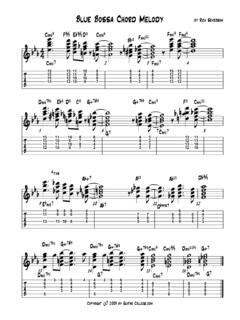Transcription of THE ELEMENTS OF MUSIC - Western Michigan University | A ...
1 1 THE ELEMENTS OF MUSIC Because MUSIC is a multi-dimensional, multimedia phenomenon, the design of a musical composition can be described on several levels. The ELEMENTS of MUSIC described below offer you specific terms and concepts that will help you better understand and describe any kind/style of MUSIC from Classical to Rock: ELEMENT Related Terms Rhythm: (beat, meter, tempo, syncopation, polyrhythm) Dynamics: (crescendo, decrescendo; forte, piano, etc.) melody : (pitch, range, theme) Harmony: (chord, progression, key, tonality, consonance, dissonance) Tone color: (register, range) Texture: (monophonic, polyphonic, homophonic) Form: (binary, ternary, strophic, etc.) RHYTHM Rhythm is the element of TIME in MUSIC . When you tap your foot to the MUSIC , you are "keeping the beat" or following the structural rhythmic pulse of the MUSIC . There are several important aspects of rhythm: DURATION: how long a sound (or silence) lasts.
2 TEMPO: the speed of the BEAT, which can described by the number of beats/second (or in Classical MUSIC by standard Italian terms) Here is a comparative chart of tempos from several different rock and roll styles: < SLOWER FASTER > Italian terms: Adagio Andante Moderato Allegro (assai) Vivace Presto Beats/minute 60 80 96 140 175 Blues Pop Funk R & B Rock and Roll 2 METER: When beats are organized into recurring accent patterns, the result is a recognizable meter. The most common meters are diagrammed below: Duple meter = two pulses per group: (2/4 time) 1 2 1 2 1 2 1 2 Triple meter = three pulses per group: (3/4 time) 1 2 3 1 2 3 1 2 3 Quadruple meter = four pulses per group: (4/4 time) 1 2 3 4 1 2 3 4 Other important terms relating to Rhythm are: Syncopation: Putting accents "off-the-beat" (Between the counted numbers) Ritardando: gradually SLOWING DOWN the tempo Accelerando: gradually SPEEDING UP the tempo Polyrhythm: more than one independent rhythm or meter happening simultaneously DYNAMICS The relative loudness or quietness of MUSIC fall under the general element of dynamics.
3 In Classical MUSIC the terms used to describe dynamic levels are often in Italian: pianissimo [pp] = (very quiet) piano [p] = (quiet) mezzo-piano [mp] = (moderately quiet) mezzo-forte [mf ] = (moderately loud) forte [f ] = (loud) fortissimo [ff ] = (very loud) < Quieter LOUDER -> pp p mp mf f ff (fff) Examples: Muzak Acoustic/Folk-rock Rockabilly Hard rock Heavy metal/Punk An ACCENT is "punching a note harder" or "leaning into a note" to emphasize it. 3 melody melody is the element that focuses on the HORIZONTAL presentation of Pitch. PITCH: the highness or lowness of a musical sound melody : a linear series of pitches Almost all famous rock songs have a memorable melody (the tune you sing in the car or the shower.) Melodies can be derived from various SCALES (families of pitches) such as the traditional major and minor scales of tonal (home-key centered) MUSIC , blues scales, or modes (such as dorian, mixolydian).
4 Melodies can be described as: CONJUNCT (smooth; easy to sing or play) DISJUNCT (disjointedly ragged or jumpy; difficult to sing or play). HARMONY Harmony is the VERTICALIZATION of pitch. Most often harmony is thought of as the art of combining pitches into chords (several notes played simultaneously as a "block"). These chords are then arranged into sentence-like patterns called progressions. hhhhh=====hh& hhhhhhCFG 7 CIIVV7 Ifunction of the chord within the key of "C"A "Progression" of 4 CHORDSe=3rda 3-note CHORD (triad)c=rootg=5tha 4-note CHORD (7th chord)g=rootd=5thf=7thb=3rd Harmony is often described in terms of its relative HARSHNESS: DISSONANCE: a harsh-sounding harmonic combination CONSONANCE: a smooth-sounding harmonic combination Dissonant chords produce musical "tension" which is often "released" by resolving to consonant chords. Since we all have different opinions about consonance and dissonance, these terms are somewhat subjective.
5 Harmony in rock MUSIC songs has undergone various phases of expansion particularly in the mid-60s due largely to the influence of The Beatles. 4 Example of a Standard 50s/ 60s Song-form Harmonic Progression 1357I vi IV V I vi IV V I vi IV V I vi IV VKey of GG Emi C D G Emi C D G Emi C D G Emi C D Phrase 1 Phrase 2 Phrase 3 AABP hrase 4A24689I vi IV V I vi IV V I vi IV V I IV I 10 IV I IV I IV I V I vi IV V I vi IV V I vi IV V I IV I111213141516171819202122232425262728293 03132G Emi C D G Emi C D G Emi C D G C G G7 G Emi C D G Emi C D G Emi C D G C G C G C G C G A7 D V7 of IVV7 of V Example: Help by The Beatles ii VII V7 Ib"Help!
6 I need somebody .." 1i3i5i7iKey of G Ami F D7 G 8-barintroPhrase 2 Phrase 3 ABPhrase 4A2i4i6i8i9I iii vi IV VII I 10 ii VII V7 I111213141516171819202122232425262728293 03132 D7 G Ami F 1357I iii vi IV VII I G Bmi Emi C F G Phrase 1A2468bG Bmi Emi C F G bb"When I was younger .." "But now these days are gone .." "Help me if you can .. and I do appreciate.
7 " "Help me get my feet .. Won't you please, please help me!" 5 TONE COLOR (or TIMBRE pronounced "TAM-BER") If you play a "C" on the piano and then sing a "C", you and the piano have obviously produced the same pitch but why doesn't your voice sound like the piano? It is because of the laws of physics and musical acoustics. Although these scientific principles are far beyond the scope of this course, it is safe to say that each musical instrument or voice produces its own characteristic sound patterns and resultant overtones, which give it a unique "tone color" or timbre. Composers use timbre much like painters use colors to evoke certain atmospheres on a canvas. The upper register (portion of its range or compass) of an electric guitar, for example, will produce tones which are brilliant and piercing while in its lower register achieve a rich and dark timbre. A variety of timbres can also be created by combining instruments and/or voices.
8 Standard Instrumental Colors used in Rock MUSIC : String Instruments: Electric Guitar Electric Bass Acoustic 6-string Guitar Acoustic 12-string Guitar (used in folk or country rock) Percussion Instruments: Drum Set (many, many colors offered here: bass drum, snare drum, tom-tom, cymbals, etc.) Hand-held percussion (tambourines, maracas, claves arte the most common) Electronic drum pad (or drum machine) Keyboard Instruments: Acoustic Piano Synthesizer (became popular in the late 60s) offers unlimited sound colors Organ (popular in 60s rock) Wind Instruments: (mostly used in Soul or Art-Rock) Saxophones Trumpets Trombones * * * 6 TEXTURE Texture refers to the number of individual musical lines (melodies) and the relationship these lines have to one another. Monophonic texture: One melody with no harmony rarely used in rock MUSIC . Homophonic texture: This texture features two or more notes sounding at a the same time, but generally featuring a prominent melody in the upper part, supported by a less intricate harmonic accompaniment underneath (often based on chordal harmony homogenous BLOCKS of sound).
9 Rock songs often use this texture. Example: Mr. Tambourine Man by Bob Dylan Q&##=========H44 QQqqq Hey, Mis - ter Tam - bou - rine Man ..VoiceGAGuitarDStrummed chords not an independent melody Polyphonic texture: MUSIC with two or more independent melodies sounding at the same time. (The more different the melodies are from one another, the more polyphonic the texture.) The most intricate types of polyphonic texture such as canon (strict echoing) are found in some types of art-rock MUSIC . Example: One of These Nights by The Eagles (1975) eqq>Very lowbass note held for 1 measureqqslidew eqq>Guitar 1 LowBeat: 1234 MediumHighINSTRUMENTEassGuitar 2 Guitar 3off-beat accentchord held for 2 measures "One of these nights, one of these crazy .."qqslide1234off-beat accentbass note held for 1 measureqqslidew 7 Imitative texture: Imitation is a special type of polyphonic texture produced whenever a musical idea is ECHOED from one performer to another.
10 123 Antiphonal texture: Antiphonal texture is created when two or more groups of performers alternate back and forth, and then play together. In Rock-and-roll, this texture is heard particularly in various types of Soul, Funk and Rap MUSIC . GROUP 1(Statement)GROUP 2(Echo) Other Considerations: What is the meaning of the text? How does the MUSIC relate to the text being sung? How is the text handled in the MUSIC ? Syllabic: each syllable of text is given only one note. Melismatic: three or more notes per syllable of text. Vibrato (an ornament): Rapid "shaking" of a pitch often used by vocalists, guitarists, and synthesizer players to add interest to long-held notes. Tremolo: The most common type of tremolo in rock MUSIC is achieved when a guitar player rapidly alternates the pick back and forth on a string. Trill (an ornament): rapid alternation of a two nearby pitches. Trills are commonly used by rock guitarists, keyboardists and brass players.













